Samsung QN85C Reviewed at $1,399.00 (55")
Product Name: Samsung QN85C
Product Description: 2023 4K Neo QLED TV
-
Design - 9.5/10
9.5/10
-
Video Quality - 9/10
9/10
-
Ports & Connectivity - 9.4/10
9.4/10
-
OS, Apps and Features - 9.5/10
9.5/10
-
Price / Quality - 9.2/10
9.2/10
Summary
Reviewed at $1,399.00 (55″)
Pros
- Very good brightness & colors
- Ideal for family use
- Excellent gaming TV
- A lot of online and smart features
Cons
- Blooming is still visible
- No Dolby Vision
- No DTS support
- Average audio
Cheapest Places to Buy :
*We are a reader-supported website. When you buy through links on our site, we may earn a small affiliate commission at no extra cost to you. Home Media Entertainment does not accept money for reviews.*
We have gone through a lot of Samsung‘s new 2023 TVs already. And although naturally most of the attention is on their top offerings, namely the Samsung S95C and Samsung S90C, the Korean manufacturer has a lot of models in the mini LED market that are worth looking into. So today in our Samsung QN85C review we are going to test the most affordable mini LED they have on sale for 2023.
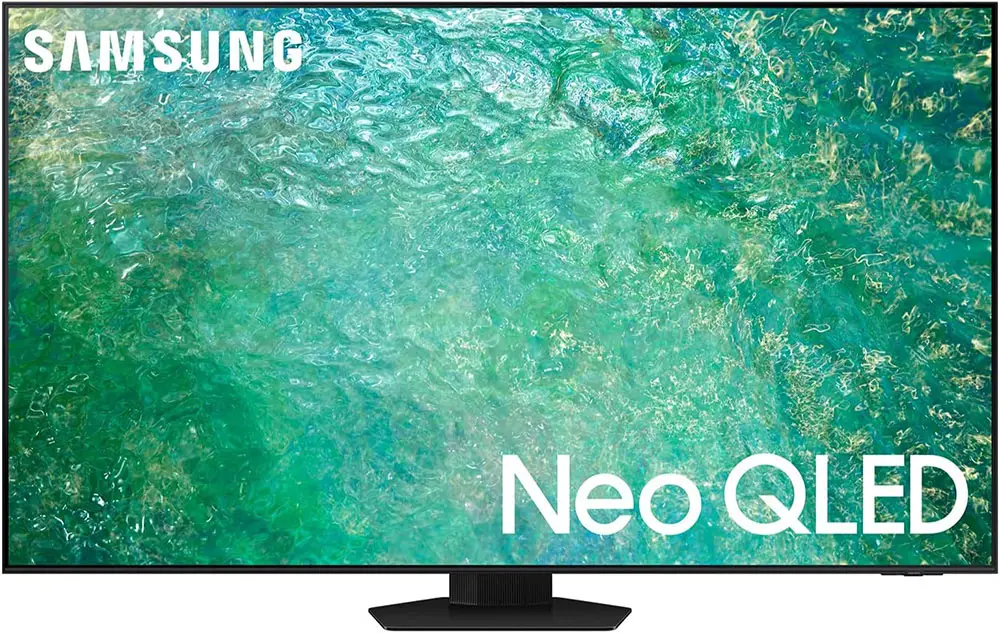
Upon first look the new QN85C seems incredibly similar to last year’s QN85B. Everything from the design to the detailed specs do not reveal any noteworthy differences. It seems that Samsung has rebranded last year’s model and released it as the new QN85C. But is this really the case?
Going over the specs real quick we find the following. The TV comes with a 100/120Hz ADS panel accompanied by a mini LED full array backlight with local dimming. Processing duties are handled by the Neural Quantum Processor 4K. It supports the HDR10+ format, comes equipped with the Object Tracking Sound audio system and utilizes the new Tizen 2023. Lastly we get four HDMI 2.1 ports that support all the latest gaming features.
As we said above the QN85C seems like it is a rebranded QN85B. But specs say only half the truth and our tests will really show if Samsung decided to rename their 2022 model for this year. So without further delay, let’s start our analysis.
Design
In terms of design the QN85C is entirely the same as the QN85B. Looking at both TVs side by side does not reveal any differences which makes our assumption that Samsung rebranded this model even stronger.
The QN85C uses what Samsung calls their NeoSlim Design which basically means that the QN85C instead of using a Full Array with Local Dimming backlight system uses the new mini LED one which helps to minimize its overall thickness. This is typical to most mini LED TVs as the smaller size of the LEDs help to make these TVs slimmer.
Measurements
The TV retains the same premium feel as many Samsung mini LED TVs have even if it is still mostly made out of plastic.
Thickness was measured at about 1.06″ (2.7 cm) which is exactly the same as last year.

Back Side
The entire back face is the same as the QN85B and is covered by a plastic panel that in true Samsung fashion has a brushed texture look on it. All ports are grouped together in an inset that is placed at the left side and all look sideways for easier access.
On the lower part we find special grooves in order to place the cables and drive them through the central stand. The power connector is placed on the right side while the only other thing at the back is the holes for a VESA wall mount.
Stand
As for the stand, this is also the same design the QN85B had. It’s a central type of stand and comes in exactly the same hexagonal shape we saw last year.
The base of the stand is made of metal, probably to give some more weight to it. While the connecting part is plastic with the back of it being hollow in order to let the cables go through it for better cable management.
The stand lifts the panel about 2.5″ which should be enough for most soundbars to fit under it.

Remote
The remote we got with the QN85C is exactly the same one as the one in some other 2023 Samsung TVs. It is very similar to the 2022 remote but there are some minor design changes. The new remote lost one button at the top and has a slightly different design with more round corners in all sides.
It is still small and uses very few buttons as it relies on the TV’s UI for most of its functions. It comes with a rechargeable battery that can be charged either through a USB-C cable or from its solar equipped back side.
The new remote is every bit as functional and practical as it was last year. The changes we got this year are minor and haven’t changed the remote’s practicality much.
Video Quality
Processor technology used
One area where the QN85C seems to get an upgrade over last year is in its processor. In 2022 the QN85B was using the Neo Quantum Processor 4K. For 2023 the QN85C got the Neural Quantum Processor 4K. This is the same processor upgrade the QN90C got this year.
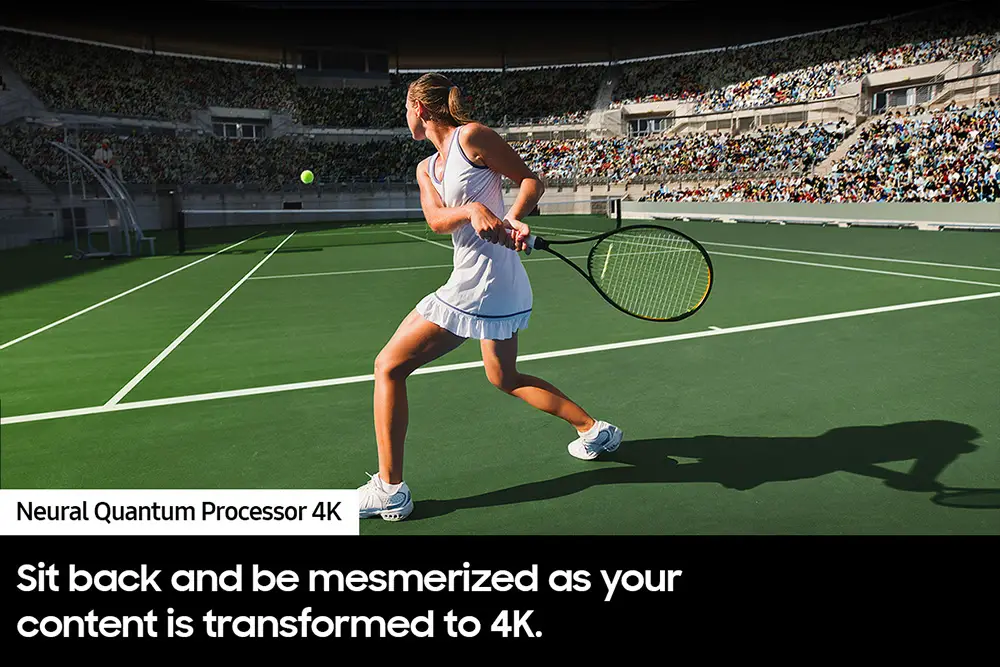
What we do know is that this processor uses up to 20 different neural network models. Each of them is trained in AI upscaling and deep learning technology. As a result the processor can optimize picture quality to 4K picture output regardless of the input quality.
Also its Real Depth Enhancer feature automatically separates objects in the content from the background. This creates a 3D like depth in order to make the image even more immersive.
Another feature that finds its way form previous years is Adaptive Picture. This can analyze the light conditions in your room and can calibrate the picture accordingly in order to provide you the best image quality for your specific situation.
Resolution and Up-scaling
For our first test we run a few videos in different resolutions ranging from ultra low quality ones, some 480p DVDs, some in 720p and obviously 1080p resolutions. We tried broadcasting signals, streaming content and discs to have a better, all around idea of the TV’s capabilities.

With low quality, low resolution content the QN85C did really good. The final upscaled images had enough sharpness to preserve a lot of details. Streaming content was also good enough, although we did notice some macro blocking from time to time.
Audio Processing
For audio the TV comes with the Object Tracking Sound (OTS) system. Along with it we get various audio features like Adaptive Sound+ and Active Voice Amplifier (AVA). But more details on these in our dedicated audio section.
Lighting technology used
The QN85C is using a mini LED backlight system which is precisely controlled by Quantum Matrix Technology. This is the same backlight system we saw in both the QN85B and the new QN90C. The major advantage of Quantum Mini LED is that it only has 1/40 the height of a conventional LED.
mini LED Explained
Instead of using a lens to disperse light, and a package to fix the LED in place, the Quantum Mini LED has incredibly thin micro layers filled with many more LEDs. This way Quantum Matrix Technology has much better and more precise control of the densely packed LEDs. This prevents what was the most obvious disadvantage of previous LED LCD backlight systems, blooming.
Keep in mind that mini LED technology is vastly superior to any other LED LCD backlight system so far. But it cannot completely erase the blooming problem that plagues LED LCD TVs. The number of zones used along with how efficient the dimming algorithms are determine how good it can be.

Number of Dimming Zones
The number of dimming zones seems to be similar to what we observed in our QN90C review.
The 55″ version of the QN85C we have for testing seems to be using 504 dimming zones in a 36 x 14 pattern. Again bigger sizes use more zones like the 65″ size that comes with 720 zones while even bigger sizes use close to 1,000 zones.
These are not confirmed numbers from Samsung, as they usually do not provide such data. But it’s what we have managed to figure out so far.
Blooming & Zones Transitioning
Blooming was still obvious in dark scenes with bright objects. But overall the effect is not so much bothering and it’s mostly noticeable in very specific scenes.
Zones transitioning was average as fast moving highlights would reveal the slow response time of the dimming zones. As a result the front part of the moving object may look darker until the zone can get into full brightness. On the other hand the zones do not transition to black very fast either. This creates a ghosting effect that does not look very good.

Overall the QN85C behaved very close to how the QN85B did. Obviously there are small differences between the two but looking how both backlights perform across all test we can call them equals.
Brightness / Contrast
Next we will be looking at the brightness of the unit. In terms of settings we used the usual as we do in all Samsung models. We used the Movie mode and Warm 2 color tone along with Local Dimming set to High.
SDR and HDR Measurements
First test is the SDR brightness over a 10% window and the number we got was 1,057 nits which is amazing. It is high enough to even combat glare in an extremely bright room which makes the QN85C ideal for any room condition.
We then switched to HDR content and in our HDR brightness over a 10% window test we measured 1,065 nits. Which again is excellent. Anything above the 1,000 nits threshold is considered very good and the QN85C falls right into this category.

Automatic Brightness Limiter (ABL)
As with most TVs nowadays the QN85C comes with an Automatic Brightness Limiter (ABL). This system lowers the overall brightness of the screen when large parts of it become very bright for a long period of time. This may not be very obvious when watching a movie for example. But you can see it more with bright static images, or if you use the TV as a computer monitor.
To be honest the ABL on the QN85C was not as aggressive as we expected it to be. This means that even with very bright images the TV kept its brightness high enough most of the time. There was some dimming, but the peak brightness is so high that even dimmed the TV was bright enough.
Last Year Comparison
In terms of brightness both the QN85C and QN85B perform very close to each other. It shows that Samsung didn’t change much in this respect. Both TVs are very bright and can handle HDR content with ease.
EOTF Tracking
Brightness levels followed the EOTF reference values extremely close up to its sharp roll-off point which results in some clipping. We tried both Filmmaker and Movie mode and both of them were very accurate. We did notice some slightly raised blacks but this was very subtle and didn’t affect the overall image quality very much.

Contrast Performance
In terms of contrast the QN85C comes with an ADS panel, which is an IPS-like panel, which means that its native contrast is very bad. But this is where the local dimming makes a huge difference.
The QN85C has a very good local dimming feature. As a result contrast with local dimming is vastly improved and is even better than last year’s model. Keep in mind that the local dimming feature is always on in the QN85C. So you cannot actually decide if you want to use it or not.
Viewing angles
The QN85C is using an ADS panel which allows the TV to have decent viewing angles. Basically here the TV is similar to the QN85B since both use the same type of panel.
Fortunately unlike some other TV models, the QN85C uses ADS panels for all its sizes, thus minimizing the consumer confusion.
From looking at the TV from different angles we would say that about 30 degrees angle was the maximum before the image would start to degrade a lot. Obviously how acceptable an image is, is entirely a personal matter. But objectively speaking anything over 35-40 degrees would make the image quality unbearable.
With this kind of viewing angles the TV can be considered very family friendly.
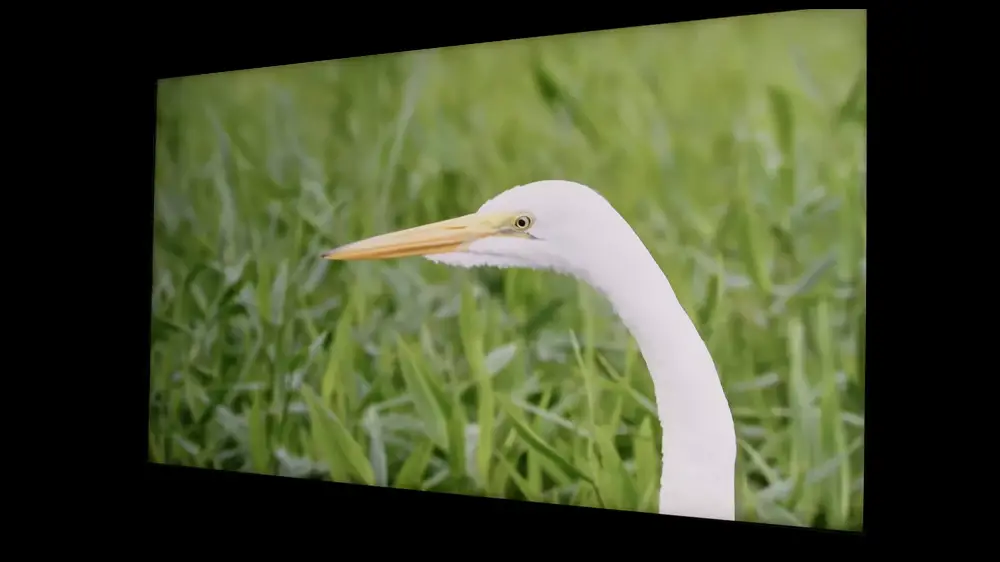
HDR support
HDR support is another area where things haven’t changed much. As it seems that most brands stick to their guns without any changing in sight. As such we get the most basic HDR10 that is required for 4K UHD playback. There is also HLG that is used mainly for broadcasting. And lastly the newer HDR10+ which is the most advanced HDR protocol. This uses dynamic metadata in order to provide the best image quality on a frame by frame basis, similar to what Dolby Vision is doing.
In the QN85C we also find HDR10+ Adaptive and HDR10+ Gaming. HDR10+ Adaptive uses its AI engine to analyze the viewing environment. This includes the lighting, brightness and even reflections using the sensors equipped on the TV.
The results are then incorporated into the dynamic metadata. After going through four further steps, the brightness and contrast of a scene are optimized. This way you can view HDR10+ movies and television programs in various environments at home.
Keep in mind that like many new Samsung TVs the QN85C comes with an HDR Tone Mapping setting. You can set this to either Static or Active with Static being more accurate. Active will increase highlight intensity but makes the image less natural.
Unfortunately, Samsung still refuses to allow Dolby Vision in their TVs and stay firm behind their own HDR10+. A big disappointment, and we have no hopes this to change any time soon.
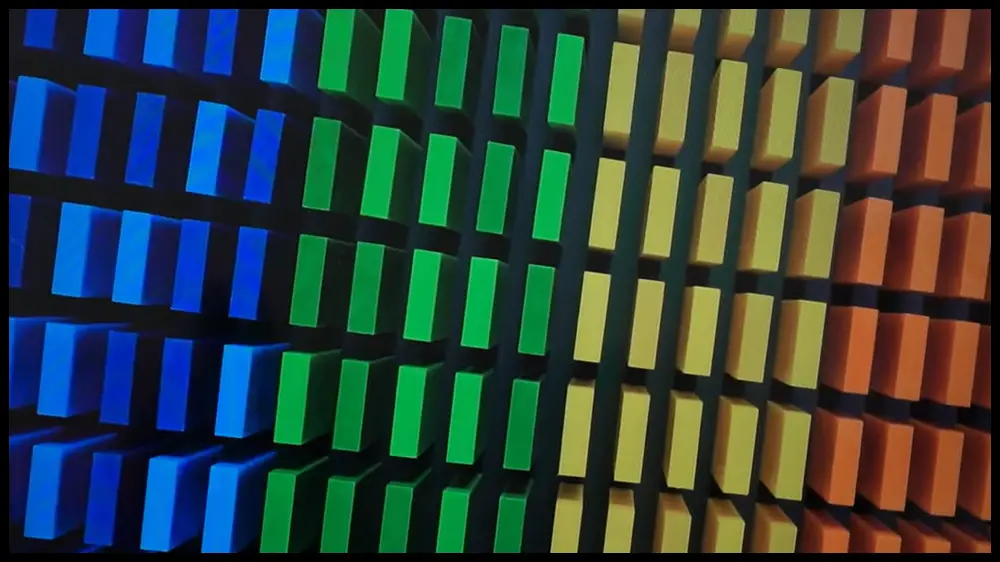
Color coverage
The QN85C, being in essence a QLED, uses Samsung’s special Quantum Dot layer. With this the TV is able to display more vivid and lifelike colors. Samsung claims 100% coverage of the DCI-P3 color space for all of their QLED and Neo QLED series. But you should never take these numbers literally as they are mostly used for marketing purposes. Real numbers usually deviate a lot from these claims.
In our case we measured the TV to have about 93% coverage of the DCI-P3 color space which is great. On the wider REC.2020 color space we got a coverage of 70% which again is very good.
The numbers we got are slightly higher than what we measured last year in the QN85B. The difference is small and not very obvious with real world content. But a small improvement is there.
DeltaE Errors
Before calibration the TV had very good color accuracy but not without some inconsistences. White balance and color temperature needed correction but on the other hand gamma was spot on. Some colors were a bit inaccurate but not by much.

After calibration all above errors were fixed. Gamma, white balance and color temperature we correct and all colors were able to stay below the DeltaE error limit of three.
Color Gradients
Most color gradients were good. But we did notice some banding in green and blue colors
There is also a Noise Reduction function in case you do see it. But if you enable it some detail is lost and in general we don’t like using this feature much.
Panel Uniformity
Grey uniformity was good but not without a few issues. We did notice some banding while the edges of the screen appeared slightly darker in comparison to the center.

Black uniformity on the other hand depended very much on the local dimming setting. Only in its high setting black uniformity was exceptionally good and this should be the recommended setting.
Motion performance
Next we will test the TV’s motion performance. And from the looks of it the QN85C is not all that different from its predecessor.
The TV comes with a 120Hz panel along with a backlight dimming frequency of 960Hz. This is exactly the configuration we saw in both the 2023 QN90C and the 2022 QN85B. Such a high frequency ensures that flickering is completely invisible but this also depends on the picture mode. Because for some of them the frequency drops to 120 Hz while for others it remains at 960Hz.
Keep in mind that there is no 144Hz support in the QN85C as we saw in some QN90C sizes. All of them can do only 120Hz at best.
The TV performed really good with minimal motion blur visible, mostly due to the very good response times. But on the other hand this results in a lot of stutter with low framerate content that can be reduced only by enabling motion interpolation. The TV can also remove judder either from 24p or 60p content, which is great for any kind of content.
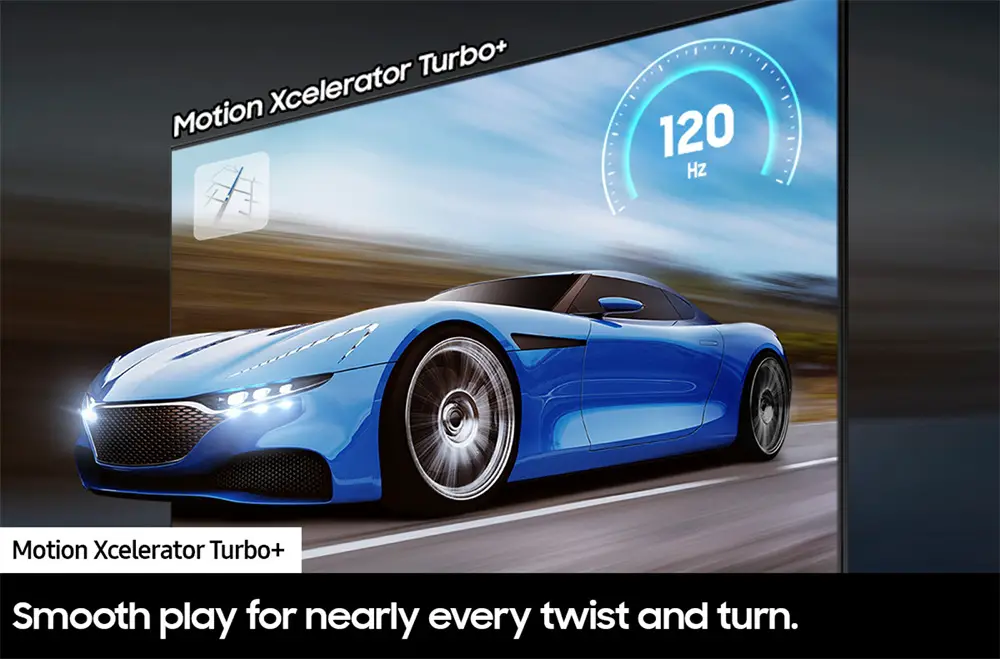
Motion Interpolation
The TV obviously features motion interpolation and in this case we get Samsung’s Motion Xcelerator Turbo+. The QN85C was capable of removing judder and stutter but as usual artifacts would become visible depending the content. When there are a lot of fast moving objects or during camera pans motion interpolation could simply not keep up.
This feature is enabled in the same way as with all other Samsung models. You will find it in the Picture Clarity settings, in the menu, and by adjusting the two sliders for blur or judder.
Keep in mind that very high values in the sliders and the “Soap Opera Effect” will appear. So if you want to improve motion keep minimal values in these two sliders. A value of 1 or 2 can smooth motion enough without affecting the quality much.
Black Frame Insertion (BFI)
Black Frame Insertion (BFI) is also available as usual which can be enabled in the menu with the LED Clear Motion option. BFI is a technique that inserts a black frame in between two individual frames in order to smooth out motion.
Although the end result is very good, it has a few undesirable side effects. First due to the black frames, brightness takes a visible hit. Also, due to the lower frequency used, which can be either 120Hz or even 60Hz, some flickering may become noticeable. And lastly BFI can result in some image duplication.

Overall Motion Impressions
The QN85C behaved extremely similar to the QN85B here. Its motion performance with or without motion interpolation and BFI did not show any major differences. This is another area where both TV are the same.
Input lag Measurements
Next we will test the TV’s input lag performance.
According to our measurements the QN85C measured an average of 10.7ms input lag in both 1080p and 4K resolutions at 60Hz. As good as it gets here. At 120Hz we measured 6.6ms in both 1080p and 4K resolutions which again is amazing.
These numbers are perfect and very close to what the QN85B could do. There are small variations but these are not major and are within normal parameters.
Just make sure you use the available Game mode in order to get so low values. As outside that the input lag will greatly increase to around 86ms which can still can be fine for slow paced, offline games but for nothing more.
One thing we need to mention is that the QN85C does support 1440p resolution but not 144Hz.
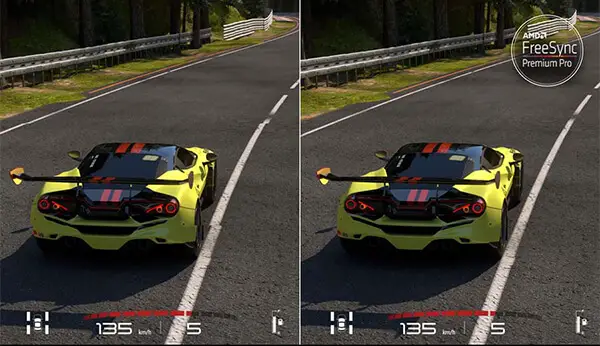
Other Gaming Features
We should also not forget to mention that the TV supports Auto Low Latency Mode (ALLM). And both the PS5 and Xbox consoles support this feature, so the TV will switch to Game mode automatically.
HGiG Mode is not missing either, as per usual with many Samsung TV models. This is HDR Gaming Interest Group’s technology that ensures you enjoy HDR games the way that their creators and developers intended.
VRR Support
The QN85C makes sure to include all VRR support there is. As such we find HDMI Forum VRR, AMD FreeSync and NVIDIA G-Sync. And you can handle all of them in the new Game Bar 3.0.
Trying Out a Few Games
As we usually do, to get a feel of the TV’s responsiveness we connected both our PS5 and Xbox series X to one of the HDMI 2.1 ports of the QN85C. The games we try out lately are the F1 2022 which supports both 60Hz and 120Hz and Dead Space which is a 60Hz experience only.
The TV did great in both games and in both 60Hz and 120Hz. We didn’t notice any delays and all our commands rendered on screen instantaneously. An overall very pleasing gaming experience, ideal for any gamer that seeks to get the best out of this TV.

Overall Image Quality Impressions
Overall the QN85C performed very close to the QN85B. In most areas both TV measured the same with the only exception being with colors. The QN85C seems to have slightly better color coverage, even though the difference is small. And to be honest, with real world content you most probably are not going to notice the difference.
Audio Quality
As most brands, Samsung developed their own audio system to use in many of their top and middle tier models. It is called Object Tracking Sound and as of 2021 there are four variants of this system depending how capable it is. We have the OTS Pro, OTS+, OTS and OTS Lite.
Audio System – Channels & Power Rating
The QN85C is using the Object Tracking Sound (OTS) variant, which again is the same as last year.
This utilizes a 2.2.2 channels configuration with 60 watts of power output.
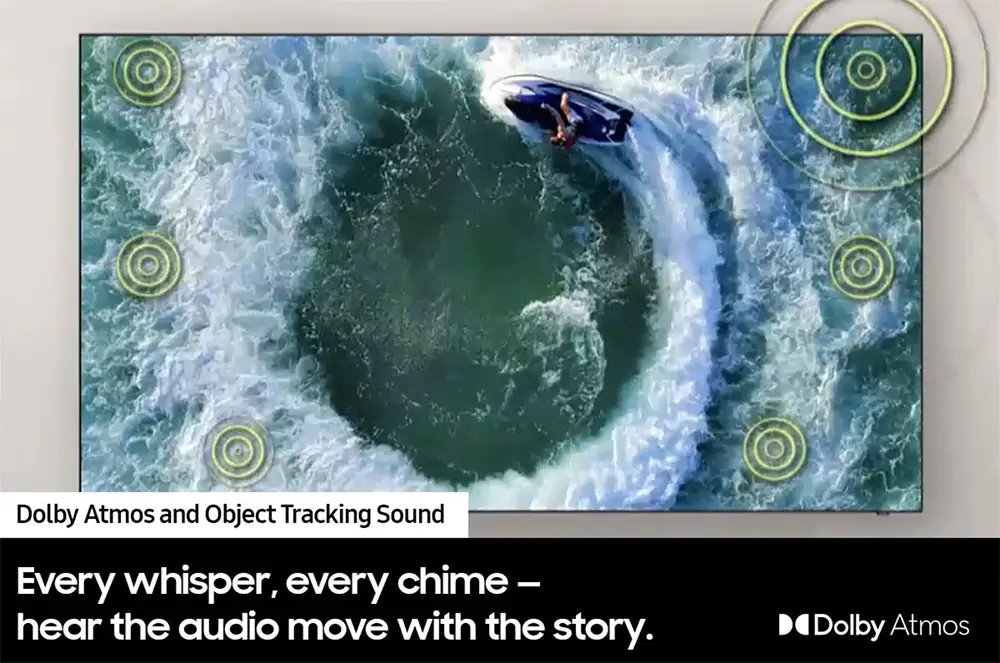
Audio Formats Support
The TV supports Dolby Atmos but this is mostly for promotional purposes as the TV cannot reproduce true surround cinematic audio. If you really want that then you will certainly need a dedicated audio system or at least a soundbar with surround speakers. Dolby Atmos can pass-through from eARC to some Dolby Atmos soundbar or dedicated sound system in this case.
Once again there is no DTS support. As such the TV cannot decode or pass-through DTS audio signals to another device. Samsung made that decision some years ago and hasn’t changed till today.
If you really want DTS then you will have to look at some other brand that still supports it in their new releases, so keep that in mind. At least, with LG bringing it back to some of their 2023 releases there is hope that Samsung will be forced to do the same in the future.
Audio Features
Samsung is adding a lot of audio features in their models, so let’s take a look at some of them.
First we find Adaptive Sound+ with which the TV analyzes the content and for each scene can identify and render the best sound type. This whole process starts by separating and classifying audio input signals. After it pulls out its key characteristics, it renders them to best suit the scene.
We also get Active Voice Amplifier (AVA). By using AVA the TV can detect environmental noise and enhance the voice output of the content you watch for a more pleasant viewing experience.
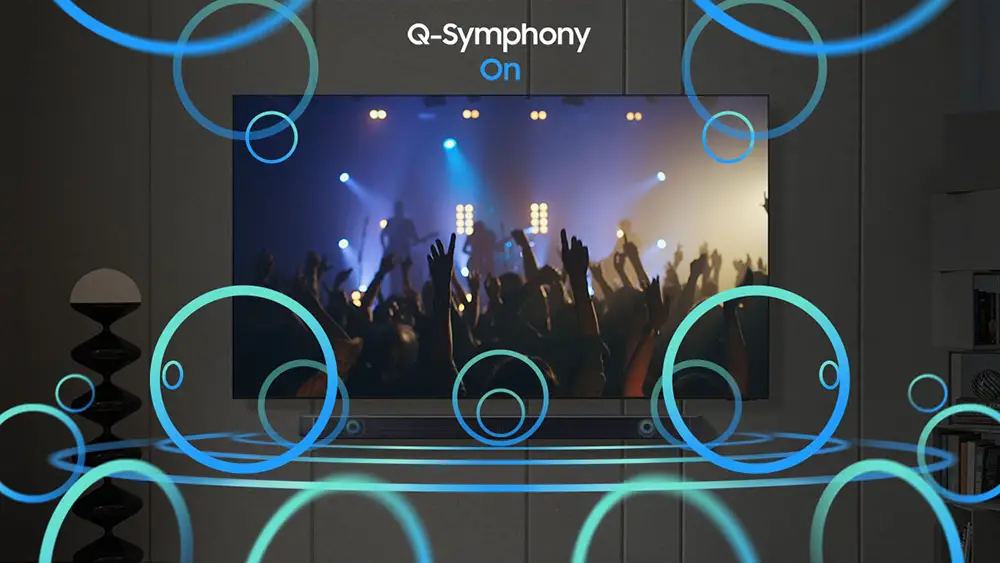
And lastly we have Q-Symphony. This is a feature that you can use to combine the TVs audio system with an appropriate soundbar that supports it.
This year Samsung released Q-Symphony 3.0 and with it the audio can sync and output from both devices for an even more immersive audio experience. Samsung released a whole lineup of soundbars that support this feature in case you are thinking of getting one.
Overall Audio Performance Impressions
The QN85C was good enough with broadcasting material. News broadcasting, talk shows, sports and TV series were all good enough. The TV can be very loud and dialog had very good clarity.
But in terms of cinematic immersion the TV failed completely. There was little depth, almost no extension and the audio lacked any weight in the lower end that is essential for action films.
Ports and Connectivity
Samsung is using the exact same layout in many of their TVs for some years now. And the QN85C is no different.
Starting from the top right we find two USB ports, a single digital optical output, four HDMI ports, an Ethernet port for wired connection to your local network, an Ex-Link port and the usual antenna/cable connector.
HDMI Specifications
Samsung, along with LG, are still the only two brands that offer four HDMI 2.1 ports with full 48Gbps bandwidth in all of them. This is due to the use of proprietary SoCs instead of using the MediaTek ones like Sony does.
As a result the QN85C supports all the features these have including 4K@120, ARC, eARC, ALLM, VRR, G-Sync, FreeSync Premium Pro, HFR and HDMI-CEC.
Connectivity Observations
And while we could not be happier with the four HDMI 2.1 ports, the inclusion of a 100Mbps Ethernet port is inexcusable in 2023.
Streaming requirements and internet connections have greatly advanced the last few years. This made the 100Mbps limit obsolete a while back. And while most TVs update their WiFi capabilities (some models support WiFi6 this year) the Ethernet adapters are still the same.
In part this is the same case as with the use of the archaic USB 2.0 ports. And although for this we can turn a blind eye to, the inclusion of 100Mbps Ethernet adapters is a major let down. Because if your wireless signal is relatively bad then your wired connection will definitely limit the quality of the streaming content you can have.
Wireless Capabilities
When it comes to its wireless capabilities the Samsung QN85C supports WiFi5 (802.11ac) along with Bluetooth 5.2 which is the same across all Samsung TVs in 2023.
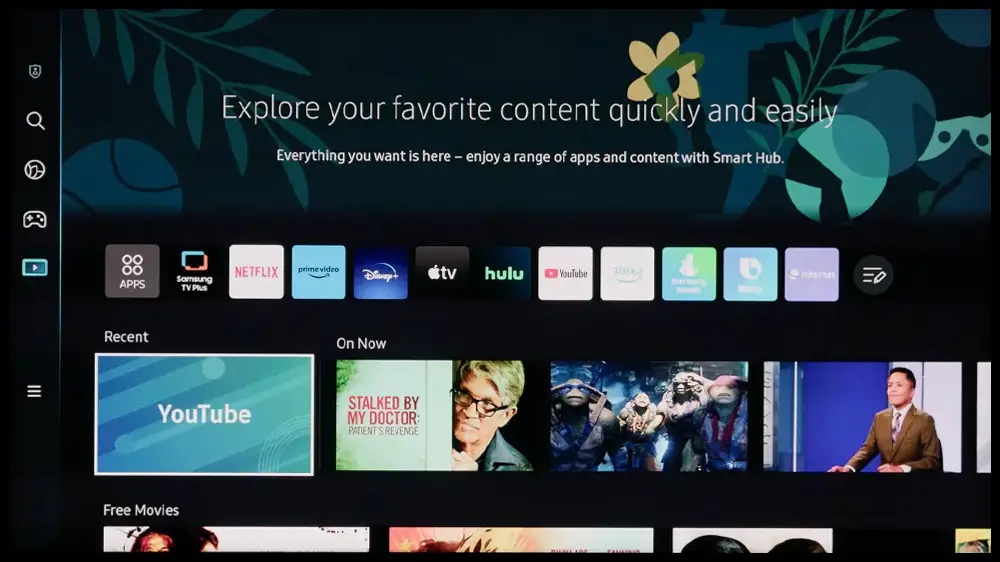
OS, Apps and Features
Samsung updated their OS to the latest 2023 version but this is only a minor upgrade compared to the 2022 version. Almost everything is still the same and this year there are small improvements and additions.
This is the same OS we experienced in most of our 2023 Samsung TVs including the Samsung S95C and QN90C among others.
Tizen 2023
Being a Samsung TV means that for its OS we find the usual Tizen platform in its 2023 edition. The new Tizen occupies the whole screen instead of being a tile based row at the bottom of the screen, exactly as Google TV and webOS are lately.
It seems that smart TV platforms opt for a more personalized experience and as such the new OS tries to provide you with options that are tailored for your viewing habits. As such you will see personalized ads, recommendations for streaming services and broadcasting channels and even shopping suggestions.
If you have used Tizen before 2022, the new version may feel a bit chaotic at first. This was the same with Google TV and webOS when they changed into a full screen UI and certainly you will need to spend some time with it to get your bearings. But once you get the hung of it, it is easier to navigate than it may seem.
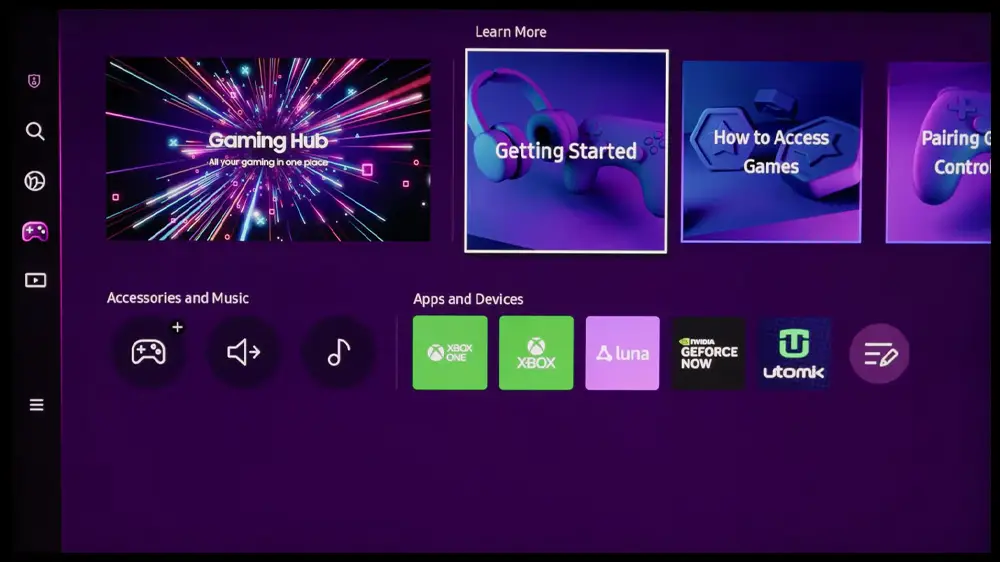
Samsung Smart TV Hub
The new Samsung Smart TV Hub includes different sections and it allows you to navigate easily through all of them. At the left of the screen there is a single column with a few central selections while the rest of the screen use rows with streaming services, apps and other functions and features available.
The new Tizen is not all that different really. Obviously the layout is tailored to Samsung’s needs but in essence it offers the same thing. Navigation was smooth enough and jumping from one app to the other was relatively fast and with no obvious lags or delays.
One feature that we got last year through a firmware update was the Samsung Game Hub. Well, this year it is available from the start in many of the new models, including the QN85C. With it you can use various online gaming services, including the Samsung-exclusive Xbox app. But as always the kind of content you will find in the Hub depends on the region you are.
Game Bar 3.0
Let’s go over some of the features we find this year. These are all the same features we saw in most of our 2023 Samsung TV reviews, so no real changes here. And the first we will talk about is the Game Bar.
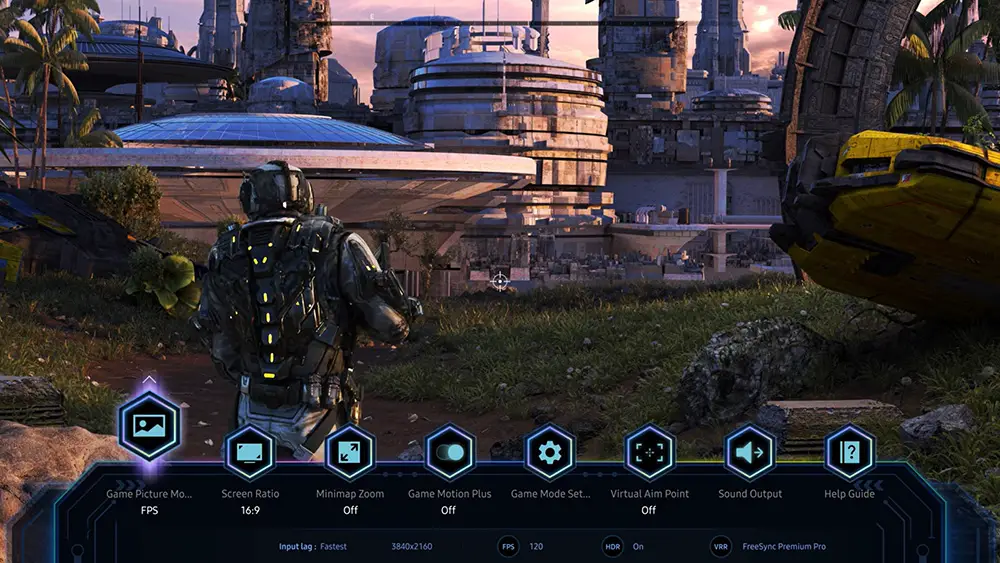
In 2023 this feature is now in its 3.0 version. This is an on-screen menu that lets you make real-time adjustments to screen ratio, input lag check, FPS, HDR, wireless headset settings and more. This can be a really handy feature to gamers as you don’t have to mess with menus every time you want to check on a specific setting. With this quick feature you have everything in front of you with the click of a button.
The new Game Bar 3.0 has a couple 2023 features that were not available before. This is MiniMap sharing and Virtual Aim Point for gaming.
Streaming Capabilities
When it comes to content the Tizen platform is famous for it’s enormous support from developers. The QN85C offers practically all known services and platforms you can think of. Netflix, Apple TV, Disney Plus, Youtube, Amazon, Hulu, Rakuten, Demand 5 and BBC iPlayer are just a few of the big names available.
There is also Samsung TV plus which offers hundreds of subscription-free channels to choose from. Many of these services can playback in both 4K with HDR like Netflix and Amazon but this really depends on each app and not on the TV itself.
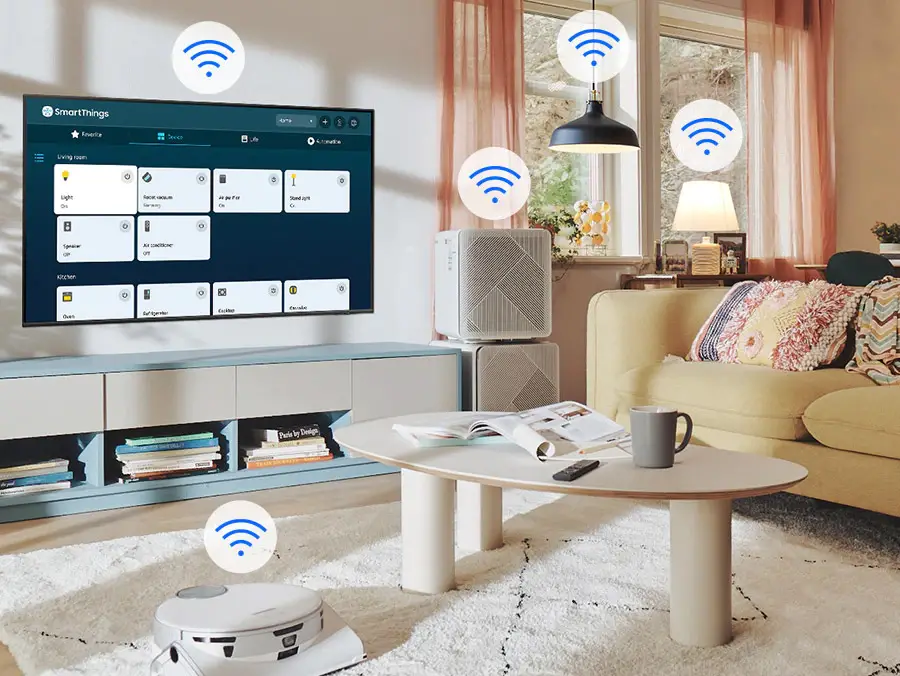
SmartThings Integration
With a Samsung TV SmartThings integration is a must. With it you can make your TV the central hub of all your smart houses devices. These can be lights, electronic locks, alarms, vacuum robots, thermostats and everything that supports the SmartThings platform.
For 2023 Samsung added Matter and Thread integration meaning you can control such devices from a single app instead of multiple ones and there is no need for an additional dongle as it is built-in the TV itself.
Voice Control
Voice control is another standard feature nowadays. It seems that Samsung is really trying to market their own Bixby service. But even if you are not very fond of that there is Amazon’s Alexa or Google Assistant to choose from. Unfortunately while Amazon Alexa is built-in, Google Assistant is not. And you will need an external device for that to work.
On the other hand, if you are an Apple guy then don’t get disappointed as there is also Airplay 2 support. And you can even use Siri through it for your voice commands. Unfortunately while Airplay is available HomeKit is not, something that hasn’t really changed lately for Samsung.
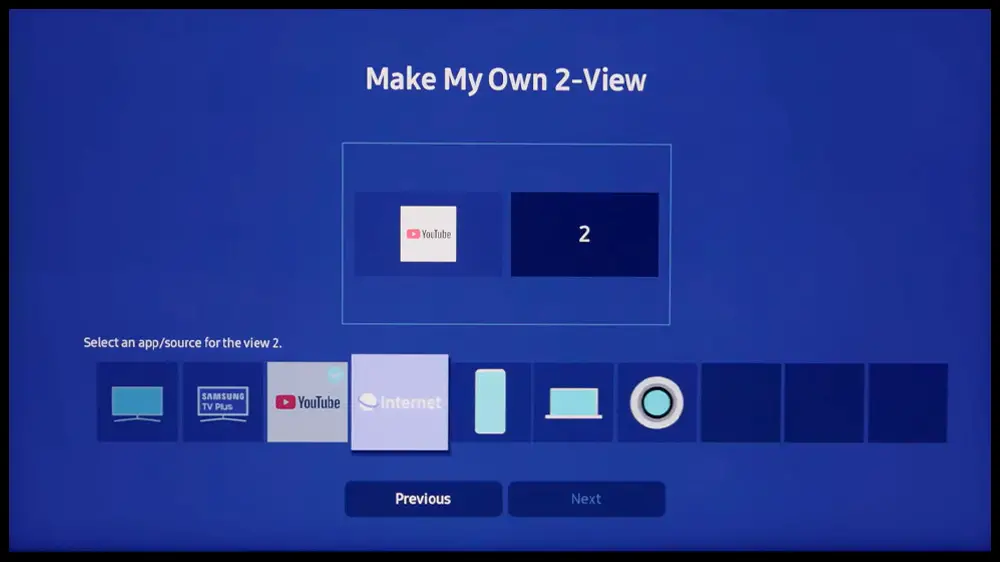
Multi-View & Tap-View
Another feature that was introduced some time ago and seems to be a standard now is Multi-View. Although at it’s core this is not something entirely new Samsung took it a step further.
Multi-View is basically a more advanced screen mirroring program. But with it instead of just simply projecting the screen from your mobile device on the TV you can choose to have two screens showing both TV content and what your mobile device shows.
In addition to Multi-View there is also Tap View. With it you can mirror your phone on your TV with just a tap to continue enjoying movies, music, and apps on the bigger screen within seconds. Nothing major, but anything that can save even a few seconds of your time can be valuable.
Ambient Mode+
Another returning feature is Ambient Mode+. This is a slightly more enhanced version of the Ambient Mode we get in many Samsung models for the last few years. With the plus version except from the ability to display various images on the TV, when not in use, it can also project various information including weather updates, news headlines, photos and music.
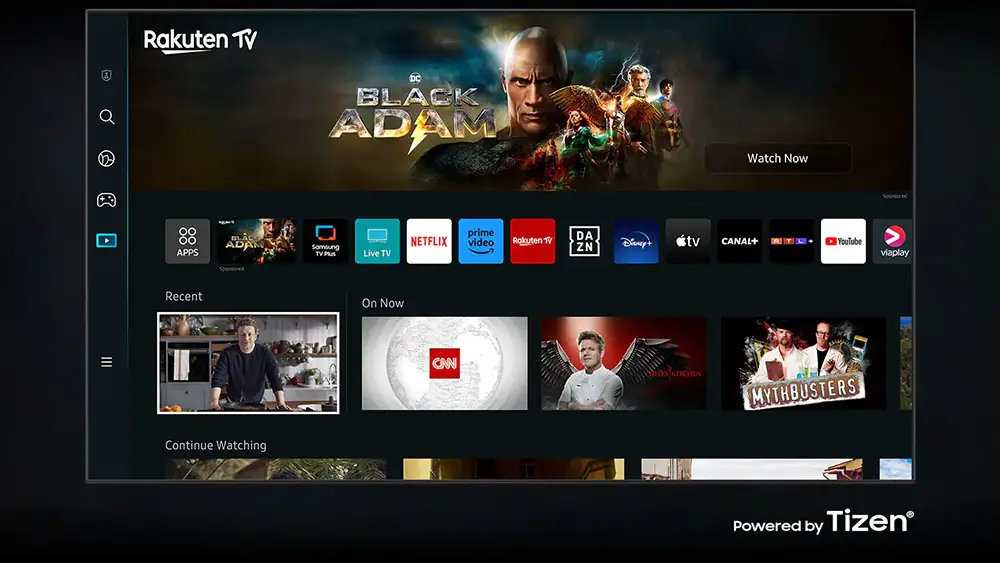
Samsung Health
Samsung Health is another standard feature by now. The last couple of years, with the coronavirus pandemic, many people were staying indoors so Samsung thought that exercise at home would be on the rise. So many of their TVs came with Samsung’s program in order to stay in shape. It seems that Samsung liked it so they decided to keep it.
Various Other Features
Other interesting new functions include a smart calibration function that works in combination to your smartphone. And also it seems that the new Samsung TVs have now access to the Philips Hue Sync app.
The differences with the 2022 are not big. Some minor additions and improvements here and there but most of them will go unnoticed. The Tizen 2023 is as good as ever and packs a lot of functionality and features.

Compared to other TVs
First comparison is obviously the TV that supposedly replaces, the QN85B. Both TVs are almost the same. The only notable difference is the slightly higher color coverage the QN85C has, the slightly redesigned remote and the 2023 Tizen. Everything else is the same. So if you can find the QN85B at a much better price then it is definitely the better choice.
From LG we haven’t tested a TV, this or last year, in the same price range so we cannot really recommend or compare it with. From Sony the one that is close in price is the 2022 X90K. Here things are not so clear cut. The Samsung is brighter, has a better backlight and local dimming while its gaming features are superior. The Sony on the other hand has better processing, slightly better color coverage and supports Dolby Vision.
Lastly we can compare it with a couple more models. One is the 2023 TCL QM8, which comes at a similar price but on the other hand is not offered in 55″, only 65″ and above. The TCL wins in almost all categories except from viewing angles and the inclusion of four HDMI 2.1 ports.
The other model is the 2022 Hisense U8H. Again the Samsung is better with viewing angles and includes four HDMI 2.1 ports. In all other categories the Hisense wins hands down. And if you consider the much lower price of the U8H, the winner here is more than obvious.
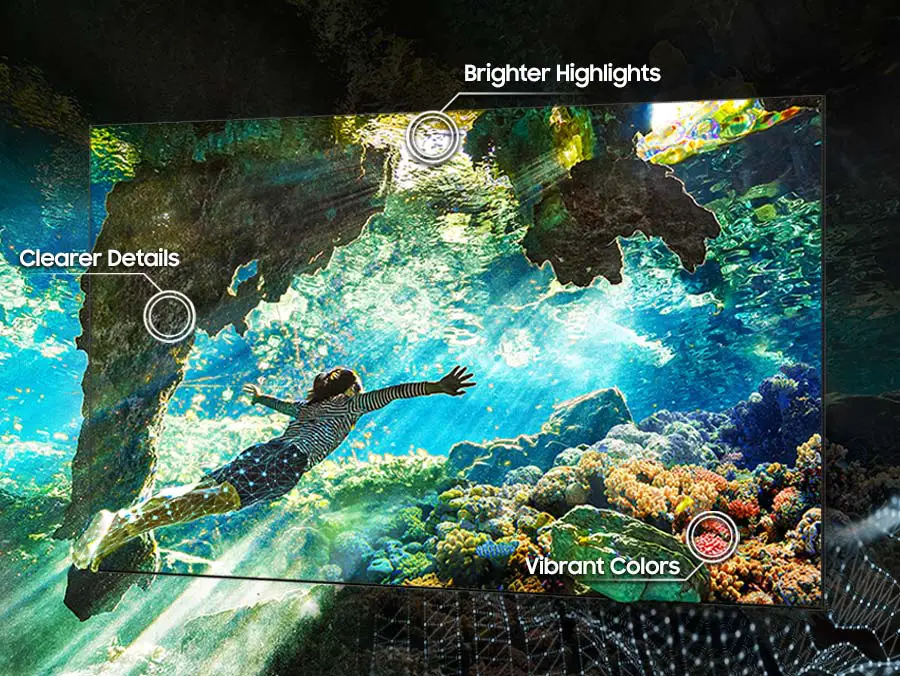
Final Thoughts
The Samsung QN85C is the most affordable mini LED TV Samsung offers this year. It may not come with any surprises as the TV is practically the QN85B with minor tweaks and changes.
Its most notable strengths include a very good backlight with local dimming, really good peak brightness, great contrast, really good color coverage and solid motion performance. Its viewing angles makes this an excellent family TV while its gaming features will make even the most hardcore of gamers happy.
On the other hand the TV has all the same weaknesses the QN85B had. Even with such a capable backlight, blooming was still visible in specific scenes. Contrast is good only if you set the local dimming to its max setting while the TV is missing both DTS and Dolby Vision. And lastly audio was a bit underwhelming for anything else other than broadcasting content.
Closing our review the Samsung QN85C remains a solid option in the mini LED arena. Obviously there are better value for money choices here from other brands, as we mentioned above, but if you definitely want a Samsung TV but budget is of great concern to you, this TV offers a good balance between cost and performance.

For more reviews you can check our dedicated 4K LED LCD TV reviews list or even look at our Product Reviews Table where you can find the brand and specific product you are looking for.
Cheapest Places to Buy :
*We are a reader-supported website. When you buy through links on our site, we may earn a small affiliate commission at no extra cost to you. Home Media Entertainment does not accept money for reviews.*

Great review on the QN85C. But I am still not sold for mini LED. I will most probably go for a cheap OLED instead. Yeah brightness may be lower but these blacks are amazing. And since I cannot afford a top of the line mini LED I guess I will go for a last year’s OLED now that I can get one in discount.
Hey Steve. It really depends on what you are looking for. If deep blacks is your first priority, then definitely an OLED is the way to go.
I’ve finally found a review worth reading! I thought your review of the Samsung QN85C was most enjoyable, and while there is a ton of information to process, there is one section that is most valuable to me as a consumer.
Your “Compared To Other TVs” section—written with the layperson in mind, distills everything down to what I, as a consumer, really want to know: Is this the best choice for me? Without meaningless (to me, anyway) buzzwords. I look forward to reading more reviews from you in the future.
Hello Terry. The comparison section was one thing that many readers of ours asked for. So we decided to implement it in all our reviews lately. I am glad you found it helpful.
Hy there. Great and informative review of the QN 85C.
I intend on buying it but have one concearn, the missing anti reflective coating, present on the QN90C for example, I read in reviews that reflections are quite bad without this coating in bright rooms. What is your point of view regarding this matter. Thank you
Hello Valentin. Well, if you could see the QN90C and QN85C side by side then the difference is definitely obvious. But I cannot tell you if the reflections on the QN85C will bother you, as this is a little bit different for each person. Personally, having tested many TVs with and without this anti-reflective coating I would say that if you plan on using this TV in a bright room then definitely get one with this extra layer. It will help a lot.
Hello Stratos,
Thanks for your quick reply.
I am using now a 55Q7FAM for 7 years and it runs perfectly smooth, I am very pleased with its reflecting capabilities also.
I want to upgrade to a Neo QLED with 75 inch display, the room is not so bright and the blinds are almost always shut. so not so bright conditions.
In my country Samsung has a promo for the 75QN85C + Q600B soundbar for 1700 USD and the 75QN90C + Q600 soundbar is 2500 USD, that is 47% more expensive. That is why I wanted to go with the QN85C. What do you say? Could you help me decide? Thank you.
Keep in mind that this anti-reflective layer is not the only difference these two models have. The QN90C is also clearly more bright than the QN85C. And also has a few features the QN85C is missing. Is it worth it for the price difference? Well, this is not something I can tell you. If I had the budget and could afford it I would definitely go for the QN90C. But your budget will show you what you can buy in the end.